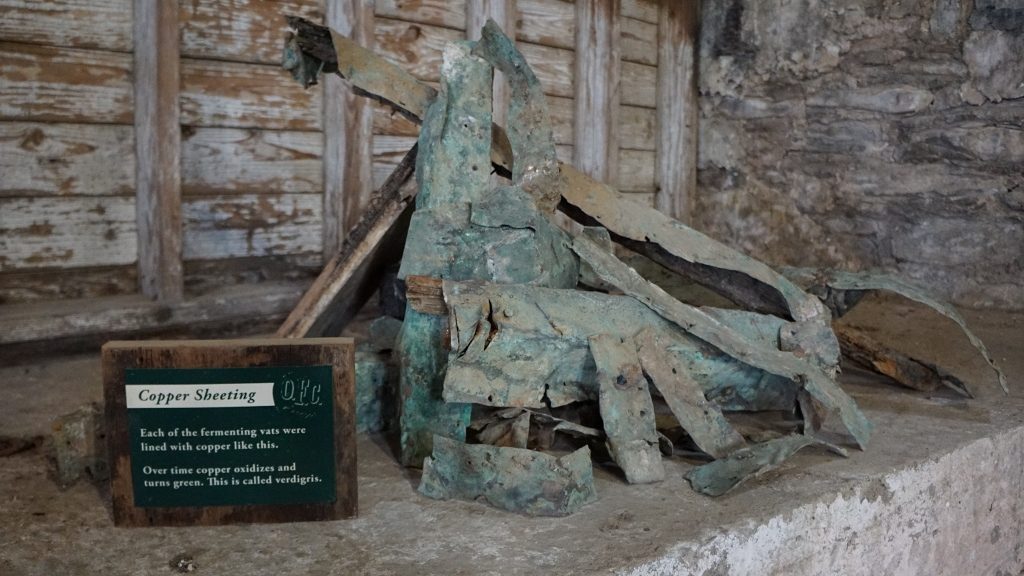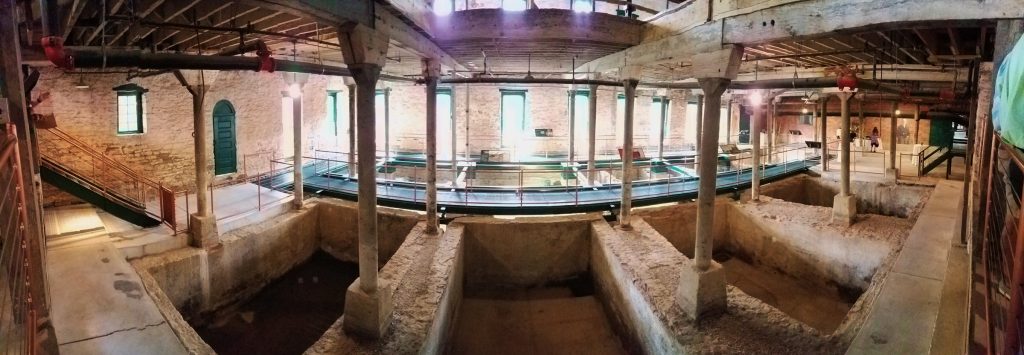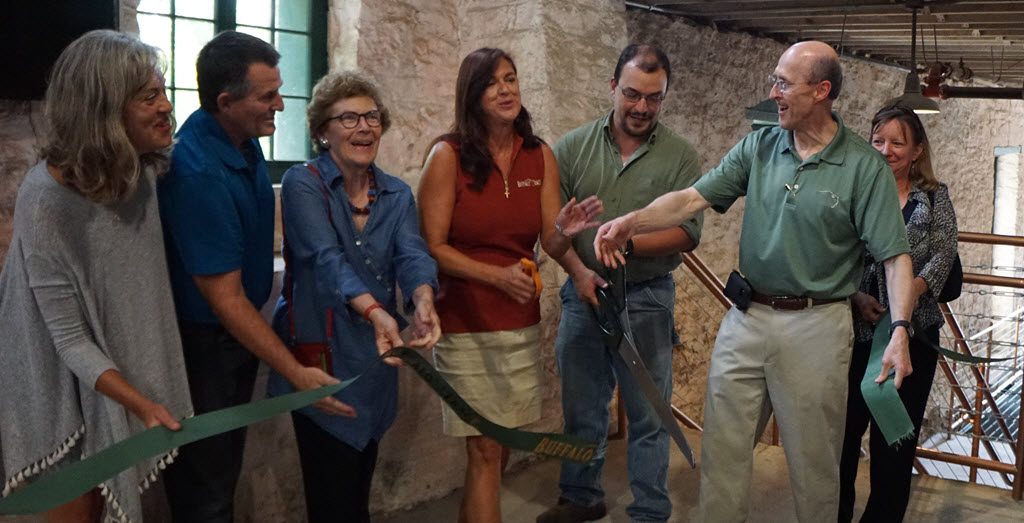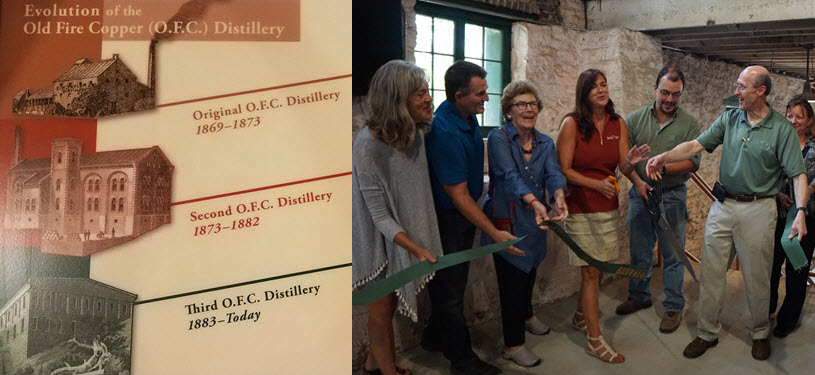
Nestled on what is now a total of 378 acres in the heart of bourbon country in Frankfort, KY, the distillery we know today as the Buffalo Trace Distillery has been making bourbon commercially for more than one and a half centuries. The area originally known as Leestown was settled around the time of the signing of the Declaration of Independence.
The First Commercial Distillery on This Site
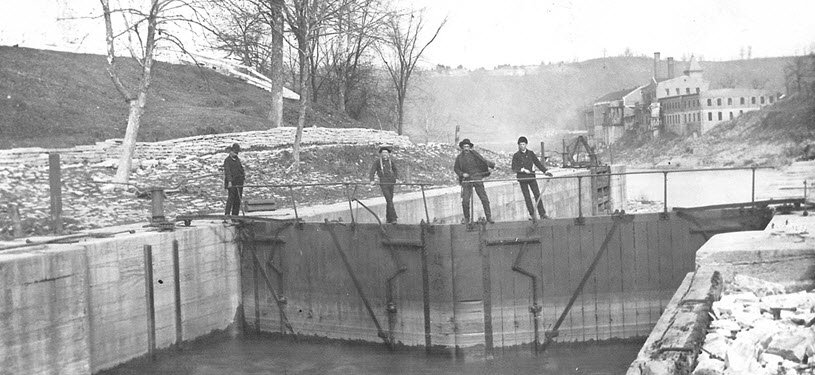
“The improvements consist of a large three story stone warehouse, a still house [probably an addition to the warehouse], wood house, and excellent pens. The machinery is of the best and most approved patterns for making copper distilled Whisky. The engine is a splendid one and entirely new, having cost a few months since, one thousand dollars.”
Historian D. G. Churchill, who has studied Daniel Swigert’s distillery and its relationship to antebellum Kentucky bourbon making, has described it as a “new type of whiskey making facility, designed for volume output, more efficient production, and ease of marketing” and a “prototype of the full-time, large-scale industrial distillery which would dominate the field in the post-Civil War era.”*
Not long after building the distillery, Swigert sold it in December 1859 to Clement and Ashton for $3,500. By the late 1860s the distillery had passed again to SJ.M. Major, Richard Tobin, and James Graham. The next sale would be the one that bourbon aficionados are most familiar with.
Col. E.H. Taylor, Jr. and the O.F.C. Distillery Era
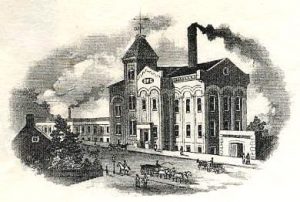
Stay Informed: Sign up here for the Distillery Trail free email newsletter and be the first to get all the latest news, trends, job listings and events in your inbox.
In 1873 Taylor replaced the original stillhouse with a new Romanesque Revival style distillery. The Bourbon Pompeii revealed a portion of the original 1869 foundation as well as the 1873 foundation. Unfortunately, the 1873 stillhouse was struck by lightning and subsequently destroyed by the resulting fire in the summer of 1882. One year later in 1883, the distillery was rebuilt with a newer, larger distillery in a similar Romanesque Revival style right on top of the 1st and 2nd distillery foundations. This is the O.F.C Distillery building that we see today.
Businesses Expand and Things Get Bulldozed
At the end of the day, the distilled spirits business is just that, a business. As businesses expand and contract, they make changes to their buildings, land and operations. In some cases they will bulldoze old buildings to make way for the newer, larger more efficient facilities. It makes sense really, you are in business to make money, and you’re not beholden to a building. The fact that parts of the original O.F.C. Distillery were buried for over 50 years under layers of concrete, stone and dirt are what make the discovery of Bourbon Pompeii so unique.
Along with today’s Bourbon boom is a boom in distillery tourism. Earlier this year, Buffalo Trace Distillery reported a 17% year over year increase in tourism and celebrated its 1 Millionth visitor. With the growth in visitors to the distillery, Buffalo Trace needed to expand to make more space for meetings and events.
In 2016, they started to renovate the lower level of the long vacant O.F.C. stillhouse building. As digging proceeded, the construction crew hit something, something big. Rather than ignoring the find and plowing ahead with their project, they stopped and called in two area experts, Historic Preservation Consultant/Whiskey Historian Carolyn Brooks and Bourbon Archaeologist Nicolas Laracuente. What they discovered was the original 1873 distillery foundation as well as fermenters from 1882.
Archaeologist and Historian Explains the Significance of this Find
Nick Laracuente is a historic archaeologist who lives and works in Kentucky. Nick was called in to take a look at the discovery. Nick is a story teller. He doesn’t tell his own stories but discovers stories as told by ancient artifacts buried under dust, dirt and in this case, concrete.
“This (Bourbon Pompeii discovery) is unique. The stuff that we are about to explore today, we’re never ever going to see again in our lifetime most likely. There are a few reasons for that. With big industrial distilleries they are living sites. As technologies improve, as the goals of the distillery change, you bulldoze, you build new buildings, you wipe the earlier versions of history away, maybe turn them into parking lots if you’re in Scotland apparently. These things don’t exist anymore.
At one point in my career I’d actually given up on looking at industrial distilleries, I thought small farm distilleries were the way to go. Then Davis calls me, ‘We are working on a project over here at Buffalo Trace, we found something old.’ And I ignored the call.
Then he calls back, ‘No seriously, you need to come over here and look at this.’ As we started to look at this, we were looking at the map and such (You can see the 1886 Sanford map of the distillery here.) and Mark asks me, ‘Can we put a date to this foundation?’ We don’t have the documents, the links to the lithographs, they don’t exist. And then the next scoop that Tim takes out with the Bobcat, we actually find the corner detail that matches up 100% with one of the lithographs for the 1873 distillery. He’s like, ‘Ok, there’s your date, it’s 1873.’ We have not only an extremely rare event of finding one early layer in the distillery, we actually have three. We have two distilleries down at the bottom and then we have the historic distillery that’s around us here.
That’s not really the only thing that makes this a once in a lifetime experience. It’s the fact that people paused, both Jarboe Construction and Buffalo Trace being able to stop and rework their project. Throw and event area into this completely unique experience, you’re not going to see it at any other distillery in the world. It’s been an honor to be a part of this project.”
Bourbon Pompeii Grand Opening Ribbon Cutting
President and CEO of Buffalo Trace Distillery Mark Brown presided over the official ribbon cutting ceremony inside the O.F.C. Distillery building. You can hear Mark’s thoughts on what he now calls, “The 8th Wonder of the World,” along with comments from historian Nick Laracuente in our related story – Buffalo Trace Distillery CEO Tells the Story of Discovering Bourbon Pompeii Video.
The O.F.C Distillery – Bourbon Pompeii Exhibit is Now Open to Public
After nearly a year of renovation, Buffalo Trace has opened up this Bourbon Pompeii exhibit for the first time to visitors. It’s called the E.H. Taylor Tour and includes three stops. You can learn more about the tour details here – Bourbon Pompeii: 59 Years After its Burial, Col. E.H. Taylor’s O.F.C. Distillery Opens to Public.
Related Stories
Explore the Ruins of the 1873 O.F.C Distillery with this Immersive 3D Tour
Buffalo Trace Renovation Turns to Excavation with Discovery of 1873 O.F.C. Distillery
Buffalo Trace Distillery Granted “Patent Pending” Status for Sour Mash Process
Please help to support Distillery Trail. Sign up for our Newsletter, like us on Facebook and follow us on Twitter.
*Resource: National Register of Historic Places


